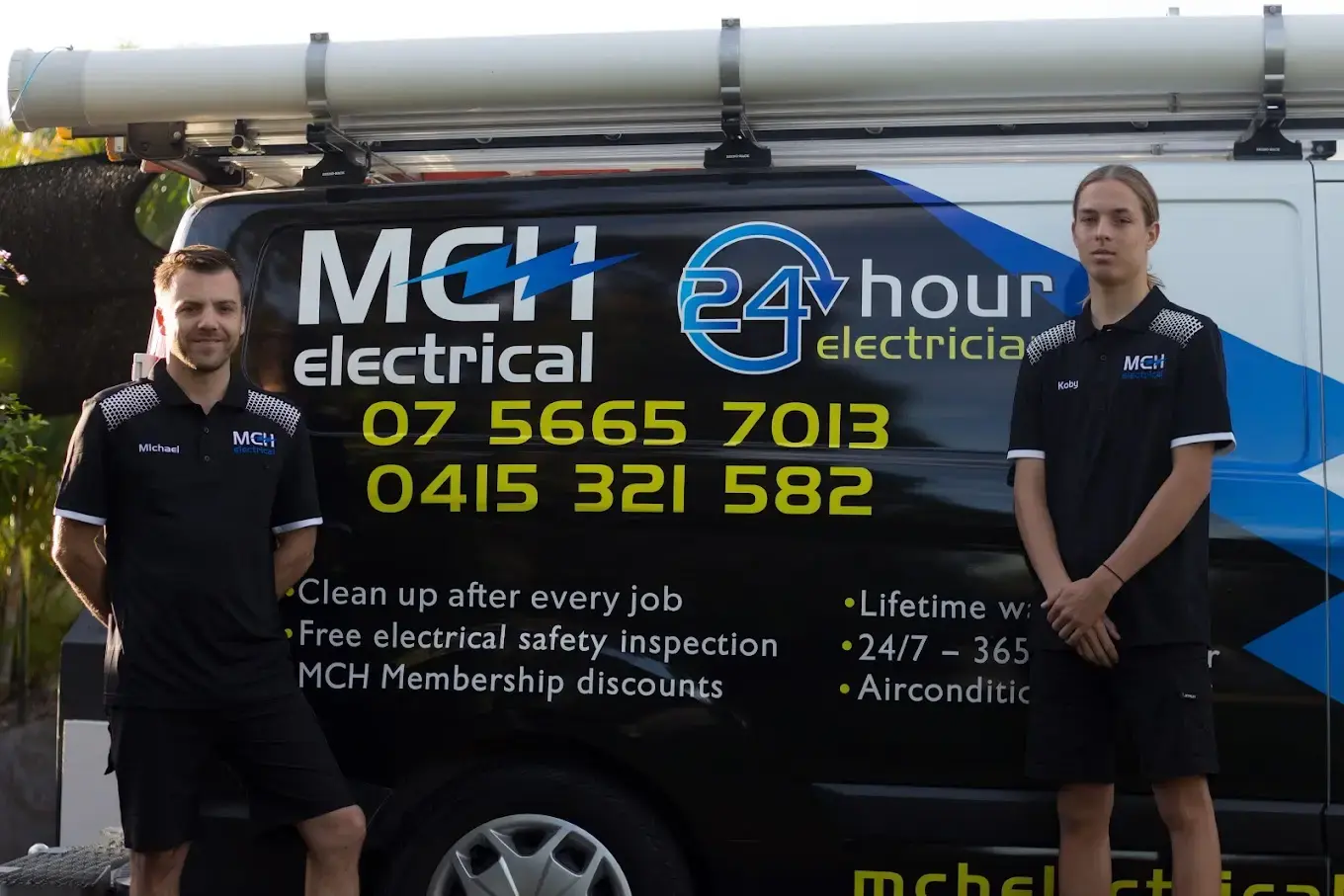
30 Apr Electrical Safety For Kids: How to Keep Your Children Safe

Electricity is everywhere — and that’s the danger.
In homes today, it’s easy to forget how risky things like cords, outlets, and appliances can be. But for kids? They’re not invisible. They’re interesting.
Children explore with their hands, mimic what they see, and rarely spot danger the way we do. A plug behind the couch or a buzzing charger might not seem like much—until it is.
More than 200 children are hospitalised in Australia each year due to electrical injuries, most at home. But the good news? Most of these risks are preventable.
Start with awareness. Add a few smart safety tools. And back it up with help from a licensed electrician on the Gold Coast when needed. That’s how you keep your kids safe — without turning your house upside down.
Understanding How Children Interact With Electricity
Not every child faces the same risks. What they explore — and how — changes fast.
Toddlers (0–4 years)
Curious. Mobile. Adorable. And very Unpredictable.
The minute you stop looking at them, trust them to crawl behind furniture, poke at power points, pull on cords, or chew on chargers. So, safety here means: block access, cover outlets, and never leave appliances plugged in on the ground.
School-age Kids (5–11 years)
Old enough to roam, not old enough to spot danger.
They may plug and unplug devices, switch things on just to see what happens, or move lamps and night lights. This is where you start teaching: what’s safe to touch, what’s not, and when to ask for help.
Teens (12+)
They know the rules, but convenience wins.
Teens overload power boards, run chargers under pillows, and use laptops in bed with drinks nearby. The focus here is on habits: why it matters to unplug, avoid overloading, and keep electronics away from water.
Each stage has its own risks. Tailor your home — and your guidance — to where your kids are now, not just where they started.
Room-by-Room Guide to Electrical Safety
Even in well-maintained homes, electrical risks can hide in plain sight. Here’s how to spot — and solve — the most common issues, room by room.
Living Room
- Behind the couch = danger zone. Cords, power boards, and unused outlets are often hidden here. Use outlet covers and secure cords with clips or shorteners.
- Power boards: Use ones with built-in overload protection. Never daisy-chain them.
- TV units & consoles: Don’t let kids unplug devices by pulling cords. Label plugs and teach how to switch off safely.
Kitchen
- Benchtop hazards: Unplug kettles, toasters, and blenders when not in use. Store cords up and away.
- Keep appliances dry: No plugging or unplugging with wet hands, and always keep cords away from sinks.
- Outlet height: If your power points are at child level, consider moving small appliances to higher shelves.
Bathroom
- No plug-ins near water. Ever. Use cordless grooming tools where possible.
- Install RCDs (safety switches): These shut off power instantly if there’s a fault — a must in wet areas.
- Store smart: Keep hairdryers, clippers, and radios unplugged and out of reach, especially near the bath.
Children’s Bedrooms
- Charging habits: Never charge devices under pillows or on beds. It’s a common cause of overheating.
- Night lights & heaters: Use ones with automatic shut-off. Never use a power board for these.
- Decorative lights: Look for Australian certification and keep cords out of reach or secured to walls.
Outdoors & Garage
- Power tools: Store unplugged and locked away. Don’t leave them plugged in “just in case.”
- Poolside outlets: Must have weatherproof covers and be RCD-protected.
- Extension leads: Use outdoor-rated cords only, and never run them through puddles or across walkways.
Quick tip: If your home hasn’t had an inspection in the last 5 years — or ever — it’s worth having a licensed electrician review your setup. A 30-minute check could prevent a major accident.
Practical Safety Tips All Parents Should Know
Children don’t know what electricity is — but they’ll still find the one power point you forgot about. That’s why electrical safety needs to be built into your daily habits, not just explained once.
Here’s how to protect them and teach them — even when they don’t fully understand.
1. Cover Power Points, Then Tell Them What They’re For
Use outlet covers on all unused sockets, especially low ones. Then explain in simple words: “This is where power lives. It’s not for fingers—only plugs.” Keep it short, repeat often.
2. Always Switch Off Before Unplugging — Say It Out Loud
Show them the habit: off first, then unplug. Kids copy what they see. Narrate it without being preachy:
“Switch off first — it’s safer that way.”
3. Keep Cords Hidden, Wrapped, or Secured
Dangling cords invite pulling, chewing, or tripping. Use wall clips, cord shorteners, or furniture placement to make cords disappear. What kids can’t see, they won’t mess with.
4. Keep Appliances Out of Reach — Always Unplug When Not in Use
Toasters, kettles, fans — unplug them fully when done. Even a cold appliance can be seen as a toy. Store small items up high, not on the bench.
5. Never Leave Phones or Tablets Charging on Beds or Couches
Heat builds fast, and kids love curling up with devices. Teach them:
“Chargers live on tables, not beds. It keeps them safe.”
6. Talk About Water and Power — With Actions
Don’t just say “don’t touch.” Show them: dry your hands first, keep devices away from sinks, and never charge in the bathroom. Say:
“Water and power don’t mix — they don’t like each other.”
7. If Something Buzzes, Sparks, or Smells Weird — Call for Help
Even older kids need to know it’s okay to say: “Mum, something’s wrong with this plug.” Encourage curiosity paired with caution.
8. Don’t Assume They’ll Understand Warnings
“Zapped” or “shock” might not mean anything yet. Instead, say:
“This can hurt your body. Smart kids like you don’t touch this”. Concrete beats abstract, every time.
9. Walk Your Home Like a Toddler
Crawl or crouch and look from their view. What’s dangling? What’s exposed? What’s shiny and touchable? That’s what they see. Adjust accordingly.
What to Check (and Fix) Right Now
If you’ve got kids at home, a quick safety check is one of the easiest ways to prevent problems before they happen. You don’t need tools. You don’t need to know technical terms. Just take 15 minutes and look for these:
1. Loose or Unused Power Points
Check for exposed, cracked, or slightly sunken outlets — especially ones not in daily use. If anything feels loose or warm, stop using it and get it checked.
2. Frayed or Twisted Cords
Inspect device cables, especially chargers, hairdryers, and lamps. If they’re pinched, splitting, or wrapped too tightly, replace them — don’t tape them.
3. Overloaded Power Boards
Look at where you’ve plugged in multiple things. If a board has more than one high-use device (heater, gaming console, printer), it’s time to spread the load or upgrade.
4. Cords on Beds, Rugs or Under Furniture
Cords under pillows or rugs can overheat. Cords running under couches or beds can wear down from pressure. Keep all cords visible, untangled, and off soft surfaces.
5. Water & Power Near Each Other
Bathroom radios, kitchen kettles, hairdryers near sinks — it’s more common than you think. Keep power points dry and appliances well away from splash zones.
6. Old Switchboards Without Safety Switches
If your switchboard doesn’t have modern RCDs (residual current devices), it’s not giving your family full protection. This is a job for a licensed electrician — and it’s one of the most important upgrades you can make.
7. Outlets That Buzz, Flicker, or Feel Hot
Even slightly unusual signs can mean faulty wiring or unsafe connections. If something looks, sounds, or smells wrong, trust that instinct and get it checked.
One final check:
Ask yourself, “Would I let a toddler crawl through this room without watching?” If the answer is no, there’s probably a fix worth making.
Smart Safety Upgrades Worth Considering
It’s one thing to teach kids what not to touch, but it’s even better when your home is built to back you up. Today’s electrical safety tools are smarter, subtler, and surprisingly affordable. These upgrades won’t just protect your kids — they’ll make your home feel calmer and safer too.
1. Power Points with Built-in Safety Shutters
These look just like regular outlets, but inside, they include spring-loaded safety shutters that only open when both prongs of a plug are inserted. That means no pens, toys, or fingers can sneak their way in.
They’re a great alternative (or upgrade) to plug-in plastic covers, which can be pulled out by curious toddlers if not fitted well.
2. Outlet Covers — Still Worth Using
Basic, inexpensive, and effective — plastic outlet covers are still a solid layer of defence for unused power points. Just make sure they’re snug and regularly checked (older toddlers can sometimes pry them loose).
3. Cord Shorteners & Cable Boxes
Tangled cords behind TVs or desks are more than just messy — they’re tempting to kids and easy to trip over. Use cord shorteners, sleeves, or storage boxes to keep wires neat, tight, and out of reach.
Bonus: it makes your space look cleaner, too.
4. Power Boards with Overload Protection
Not all power boards are equal. Look for ones with:
- Overload protection
- Reset buttons
- Surge protection
- Child-proof switches or
- shuttered sockets
A cheap board might handle your chargers, but it won’t stop a dangerous short.
5. Night Lights, Heaters & Devices with Auto Shut-Off
Kids fall asleep. Devices get forgotten. Look for night lights, space heaters, or sleep machines with timers or automatic shut-off. It’s one less thing to check before bed — and one more safety net.
These upgrades don’t need to happen all at once. But every change adds a layer of security and slowly turns your home into a place that protects your kids, even when you’re not looking.
When to Call an Electrician

Some electrical risks are better left to a professional, not because they’re complicated, but because they carry serious consequences if left unchecked.
Here are a few signs it’s time to call in licensed help:
- Old or Unknown Switchboards
If your home doesn’t have visible safety switches (RCDs) or you’re unsure about your switchboard’s condition, it may need updating. It’s one of the simplest ways to make your home safer for kids. - Outlets That Buzz, Flicker, or Feel Hot
These symptoms can indicate a loose wire or overloaded circuit. It’s best not to wait — a quick repair could prevent a larger issue. - Loose or Damaged Power Points
Even if they’re still working, worn outlets should be replaced to avoid accidental shocks or sparking. - Renovating or Baby-Proofing?
If you’re rearranging rooms or setting up a nursery, it’s a good time to assess outlet placement, cord safety, and load capacity. - Not Sure What’s Safe?
That’s exactly what an inspection is for. A qualified team can quickly point out what’s fine — and what’s not.
MCH Electrical is a trusted Gold Coast-based electrician that works with families across the region. We understand how homes here are built, how local weather affects wiring, and what it takes to make a house truly child-safe, without pressure or upselling.
Sometimes, peace of mind is the fix that matters most.







Sorry, the comment form is closed at this time.